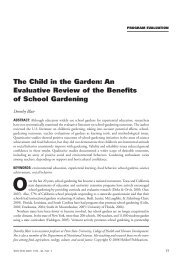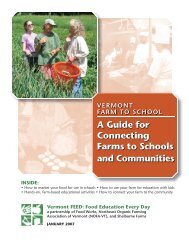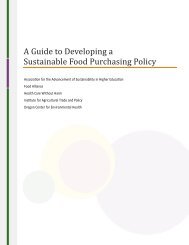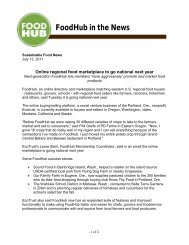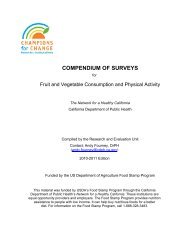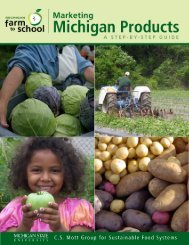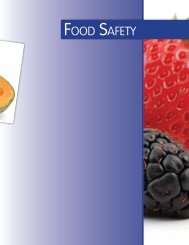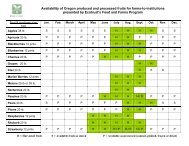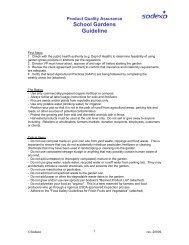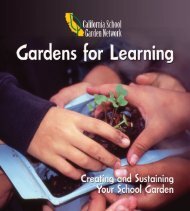eval report cover.indd - New Jersey Farm to School Network Wiki
eval report cover.indd - New Jersey Farm to School Network Wiki
eval report cover.indd - New Jersey Farm to School Network Wiki
You also want an ePaper? Increase the reach of your titles
YUMPU automatically turns print PDFs into web optimized ePapers that Google loves.
LSB-CA: LOS ANGELES UNIFIED SCHOOL DISTRICT(LAUSD), CALIFORNIA – PILOT SALAD BAR PROGRAMConclusions <strong>Farm</strong> <strong>to</strong> <strong>School</strong> and RecommendationsProgram ProfilesIn the fall of 1999, a pilot salad bar program and nutritioneducation were implemented by LAUSD Department ofFood Services and the Center for Food & Justice (thencalled the Community Food Security Project). Collabora<strong>to</strong>rsfrom the UCLA <strong>School</strong> of Public Health conductedan <strong>eval</strong>uation <strong>to</strong> measure possible changes in fruit andvegetable consumption of elementary school children attendingthree schools in the LAUSD after the introductionof the salad bar program. Nutrition education componentsincluded salad bar etiquette training, simple messages abouthealth benefits of fruits and vegetables, and trips <strong>to</strong> farmsand farmers’ markets. Th is was a pre-post study, i.e. baselinedata was collected using the same <strong>to</strong>ols and methodologybefore the implementation of the salad bar program.<strong>School</strong>s participating in the program <strong>eval</strong>uation were: 59thStreet, Castelar, and 42nd Street Elementary <strong>School</strong>s. Thestudent <strong>eval</strong>uation components included:1. Ninety-six and 241 children who lived in low-incomeneighborhoods were interviewed for 24-hour dietary recallin the years 1998 and 2000, respectively. To be included inthe study, the children needed <strong>to</strong> attend one of the three pilot salad bar schools, be in thesecond <strong>to</strong> fifth grades at the onset of the study, and return informed consent forms signedby parents or guardians. Participation in the study was voluntary. Food intake was analyzedusing the Food Intake Analysis System (FIAS) developed by the Human Nutrition ResearchCenter at the University of Texas <strong>School</strong> of Public Health Version 3.98.2. Lunch room observations were conducted in year 2000.Los Angeles Unified<strong>School</strong> Disitrct, CAFree / reduced mealeligibility: 77.2%Total schools: 768Enrollment: 722,319Demographics: 73.2%Hispanic, 11.4% AfricanAmerican, 8.8% WhiteLocal product usedin: Salad bars as a USDAreimbursable meal optionOther programcomponents:Salad bar etiquette training,nutrition and healtheducation, trips <strong>to</strong> farmsand farmers’ markets3. Focus group discussions were conducted in the three schools at the beginning, middleand end of the study period <strong>to</strong> assess the nutritional information delivered and the children’sattitudes <strong>to</strong>wards the salad bar. A <strong>to</strong>tal of 13 focus group discussions were held.Th is study used a 24 hour dietary recall method <strong>to</strong> assess fruit and vegetable consumptionin students. Regardless of the age of the child, the average frequency of fruits and vegetablesconsumed increased after the introduction of the salad bar. Th e increase in frequency offruits and vegetables consumed as <strong>report</strong>ed in this study and the associated reductions inintake of fats is consistent with previous studies conducted.Slusser WM, Cumberland WG, Browdy BL, Lange L, Neumann C. A school salad bar increases frequency of fruitand vegetable consumption among children living in low-income households. Public Health Nutrition. Publishedonline 5 July 2007.74 Bearing Fruit: <strong>Farm</strong> <strong>to</strong> <strong>School</strong> Evaluation Resources and Recommendations



